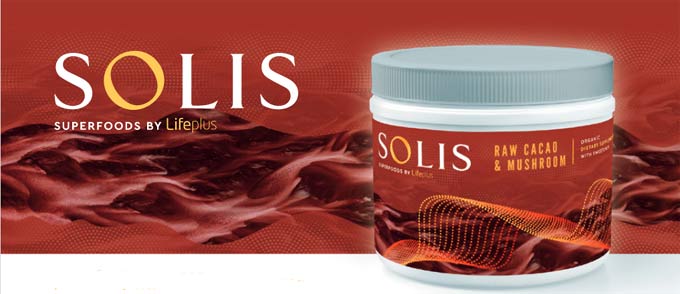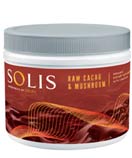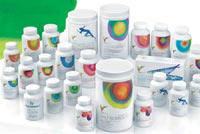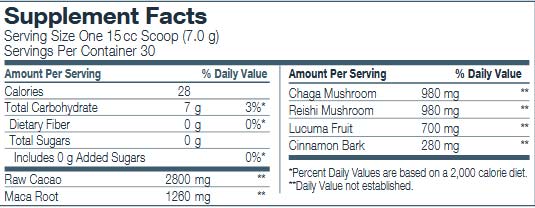| Cacao (Theobroma cacao)...originally native to South America, was held in such reverence by the indigenous people that, after Europeans made contact in the 15th century, their botanists gave it the name Theobroma, which literally translates to ‘food of the gods’. Later science revealed that flavanols and methylxanthines are the most recognizable active components of cacao. The dominant flavanols are polyphenolic structures known as oligomeric proanthocyanidins (OPCs), of varying chain length, which are potent antioxidants, inhibit lipid peroxidation and affect production of lipid and lipid-derived molecules which regulate the immune response.
Evidence from clinical studies has also demonstrated that theobromine from cacao consumption significantly supports healthy blood lipids, thus supporting healthy cardiovascular function.
These molecules (proanthocyanidins) appear to be key players in the increase of beneficial microbes (such as Lactobacilli) in the human gut microbiome, and are also associated with the decrease of less beneficial ones, (e.g., Clostridia), that follow cacao intake. Recently, it has been noted that cacao and/or chocolate modifies intestinal flora similarly to the way that probiotics and prebiotics (i.e., fiber) do.
As we learn more about the critical health-maintaining functions of the human microbiome, it seems that some of the health benefits of cacao may be due to this indirect mechanism by modulating the gut microbiome.
Raw unsweetened cacao powder is rich in both methylxanthines, which support healthy lung function, and polyphenols, which help to support healthy inflammatory responses. Methylxanthines found in cacao include theobromine (the dominant one), caffeine, and theophylline (the dominant methylxanthine found in tea). These methylxanthines have effects on the central nervous system because they readily cross the blood-brain barrier and have been intensively studied from a physiological and a clinical point of view.
It appears that cacao flavanols/proanthocyanidins are able to support healthy blood flow to the brain and, along with the methylxanthines theobromine/caffeine/theophylline, also participate in supporting healthy mood, memory, and other cognitive functions, both in healthy young adults as well as in older people with mild cognitive impairment. Cacao (in high-polyphenol dark chocolate) has been shown to support healthy moods, and also to help enhance calm feelings and contentment.
Five of eight studies in a recent review of chocolate’s effects, showed an improvement in mood. Healthy subjects in one study felt calmer, more content, and showed improvement in mood after daily consumption of a polyphenol-rich dark chocolate drink. On the other hand, those that consumed a placebo polyphenol-free chocolate drink, experienced no changes in mood.
According to researchers, flavanols that get absorbed with consumption of cacao penetrate and accumulate in brain regions such as the hippocampus which are key to memory and learning.
The polyphenols/OPCs in cacao support healthy brain function by promoting the formation of new neurons, protecting neurons from death by free radicals (oxidative stress), enhancing connections between neurons, and improving the functioning of neurons.
In human double-blind, placebo-controlled studies, both in healthy young adults and in the elderly with mild cognitive impairment, high-polyphenol cacao supported healthy cognitive function. The “Cocoa, Cognition, and Aging (CoCoA)” study, published in the medical journal Hypertension, showed that elderly individuals consuming a high-polyphenol cocoa drink daily for eight weeks significantly improved their performance on cognitive tests compared to those who consumed a low-polyphenol cocoa drink. Even single doses of high-polyphenol dark chocolate have been shown to improve performance on memory and other cognitive tests in healthy adults.
Noteworthy: The Mars corporation, the sixth largest privately held corporation in the US, patented OPC extracts from cacao containing between five and 12 repeating catechin molecules, as antioxidants with utility as food preservatives, and also to support healthy cell growth. The Mars corporation was also issued a patent for cacao derived OPCs titled “Use of procyanidins in the maintenance of vascular health and modulation of the inflammatory response.” More recently, in an animal model of mice fed a high-fat diet, dietary cacao has been shown to support healthy inflammatory responses in obese mice.?Grassi et al. reported that short-term administration of dark chocolate supports maintenance of healthy insulin sensitivity and blood pressure levels in already healthy persons.
Chaga mushroom (Inonotus obliquus), This mushroom prefers birch trees as its host, and has long been used in Russia, where it is commonly found in birch forests, and harvested for its nutritional qualities. It also grows wild in birch forests of Asia and North America, and is also now widely commercially cultivated. Very few westerners had heard of chaga before Solzhenitsyn wrote about it in his 1968 novel ‘The Cancer Ward.’
Since that book was published, more than 1,600 scientific research papers have investigated the health benefits associated with chaga. When broken up and mixed in a tea, the mushroom has a pleasant, earthy taste with hints of vanilla. Because it grows under such harsh conditions, the chaga mushroom packs itself with many biologically active compounds, which are also active in humans.
These include melanin, antioxidant enzymes, triterpenoids, ergosterols, desquiterpenes, betulinic acid, polysacchrides, and phytosterols. In pre-clinical (i.e. laboratory) research, chaga mushrooms have been documented to support healthy inflammatory and immune responses, healthy energy levels, healthy DNA structure and function, and reduce oxidative stress.
In experiments in a mouse model, it was shown that the polysaccharides of chaga are capable of supporting already healthy levels of glucose, triglycerides, fatty acids, and cholesterol in blood. None of these activities have yet been documented in human clinical trials, but the long history of anecdotal reports from people using chaga mushroom as part of their diets are consistent with at least some of these activities documented in laboratory research.
Reishi (Ganoderma lucidum) has a long history of use for promoting health and longevity in China, Japan, and other Asian countries. In China this mushroom is known as lingzhi, in Japan it is known as reishi, which is the name most commonly used in the US for this mushroom. Dried reishi fruiting bodies are about 30% protein, 40% carbohydrate, 2-5% fat, and the remainder is fiber (prebiotic). Reishi protein contains all the essential amino acids, and is particularly rich in lysine and leucine. Biochemically it is complex. In addition to vitamins and minerals, it contains a wide variety of bioactive molecules, such as terpenoids, steroids, phenols, nucleotides and their derivatives, glycoproteins, and polysaccharides. Polysaccharides, peptidoglycans, and triterpenes are the three major constituents in Reishi that interact with human physiology.
The first triterpenes were isolated in 1982, and named ganoderic acids A and B. Since then, more than 100 triterpenes with known chemical compositions and molecular configurations have been reported to occur in reishi. Among them, more than 50 were found to be new and unique to this mushroom. Reishi is clearly rich in triterpenes, and it is this class of compounds that gives the herb its bitter taste and is believed to confer various health benefits, such as supporting healthy blood lipids, and healthy free radical scavenging activity.
Many laboratory studies have shown that reishi and its extracts support healthy cell growth, both in tissue culture, and in animal studies. There was one randomized human clinical trial done in 2003 that used a patented polysaccharide extract of reishi and showed that this extract supported healthy immune function, physical performance, as well as quality of life. Clinically relevant antioxidant activity of reishi has been well documented in humans—antioxidants from reishi were found to be absorbed quickly after ingestion, resulting in an increase in the plasma total antioxidant activity of human subjects. Both animal and human studies indicate that reishi also supports healthy human immune functions.
Animal studies have shown strong ability for reishi to protect against toxic injury to both the liver and stomach. In both animals and humans, reishi has shown the ability to support healthy glucose metabolism.
Maca Root (Lepidium meyenii) Native to the Andean region, maca has been cultivated for at least 2000 years, where it has been a staple food for the indigenous people. Botanically it is a member of the brassica family, which includes cabbage, broccoli, cauliflower, and watercress. As an herb, maca is classified as an ‘adaptogen’, meaning that it normalizes functions, and increases resilience toward stress of any type. Normalizing means that physiological parameters that are too high are lowered, and those that are too low, are raised.
Maca root is rich in fiber, a large number of essential amino acids, fatty acids, and other nutrients, including vitamin C, copper, iron, and calcium. Besides these essential nutrients, this root contains bioactive compounds responsible for benefits to the human body, which has caused a considerable increase in its consumption in the last 20 years worldwide. In 1961, the first secondary metabolites were determined, reporting the presence of glycosides, tannins, alkaloids, and saponins, and later, also the macamides and the macaenes.
Animal and human studies of maca have shown evidence for support of healthy brain and cognitive function, reduction of oxidative stress, support of a healthy inflammatory response. In animal models, maca showed ability to support healthy glucose and insulin metabolism, healthy blood lipid metabolism, healthy free radical scavenging, and healthy production of endogenous antioxidants, such as glutathione. In animal models, maca supported healthy brain function as evidenced by improved spatial learning, and memory functions.
In both animals and humans, maca increased sexual desire (after eight weeks of daily intake), as well as fertility, sperm counts and volume of ejaculation. In athletes, maca increased physical performance by 10%, and oxygen consumption was increased by 30% after 60 days of supplementing with 1.5 grams of maca. Studies with rats forced to swim to the point of exhaustion after 30 days of maca supplementation, showed that those given higher levels of maca could swim longer, and markers of oxidative stress (superoxide dismutase and catalase enzymes, lactate dehydrogenase, lipid peroxides) were lower. Antioxidant capacity and the ability to produce ATP were both increased in the maca group.
Lucuma (Pouteria lucuma) Lucuma is the fruit of a tree native to South America. The fruit has soft, yellow flesh with a sweet flavor that’s often likened to a mix of sweet potato and butterscotch. Outside of South America, it is most often consumed as a dried powder. Lucuma has been used as a traditional remedy in South America for centuries, and has been called ‘the gold of the Incas’.
Due to its sweet taste, it’s often used as a healthier alternative to table sugar and other popular sweeteners. It is also rich in antioxidants such as carotenoids and flavonoids and is touted for its high fiber content—one third of the powdered fruit being soluble and insoluble fiber.
Its soluble fiber (prebiotic) promotes a healthy intestinal microbiome, and provides short-chain fatty acids, which are the primary food for our intestinal cells. The carotenoids in lucuma are primarily from the family known as xanthophylls, which are particularly beneficial to maintaining eye health
Cinnamon (Cinnamomum) is a spice valued both for its flavor and its health supporting properties since antiquity. Modern science has validated that this spice, produced from the bark of a tree indigenous to Asia does indeed carry many health-supporting qualities. Cinnamon is very rich in highly potent polyphenolic antioxidants. The distinct smell and flavor of cinnamon are due to an oily compound known as cinnamaldehyde, which scientists believe may be responsible for many of cinnamon’s powerful effects on health and metabolism.
In a study that compared the antioxidant activity of 26 spices, cinnamon wound up as the clear winner, even outranking spices such as oregano and garlic. In fact, it is so potent that cinnamon can be used as a natural food preservative. In addition, the powerful polyphenolic antioxidant compounds in cinnamon also help support a healthy inflammatory response, which resolves after it is no longer needed for healing.
Cinnamon is one of the most powerful natural products for supporting glucose metabolism, primarily by helping to maintain already healthy insulin sensitivity, but it also reduces the amount of sugar absorbed from the intestine as well. Cinnamon also helps support healthy blood lipids and already healthy, good cholesterol levels. Each serving of Raw Cacao & Mushroom supplies 280 mg of cinnamon.
In animal models, cinnamon powerfully supports healthy brain function, though this has not yet been studied in humans. Likewise, laboratory experiments show that cinnamon supports healthy resistance to abnormal cell growth, but this has not yet been evaluated in humans. Cinnamon also supports a healthy oral microbiome, and freshens breath both by its effect on the oral bacteria, and also the pleasant odor of cinnamon if it’s been chewed.
Stevia (Stevia rebaudiana) Extracts from stevia leaves have been used for centuries in South America. Today, scientific evidence on stevia supports its historic precedent in the support of healthy levels of blood sugar and insulin. Steviosides (the compounds responsible for the sweet taste of Stevia extracts) help sustain insulin sensitivity, and also slow the production of sugar by the liver, a process known as ‘gluconeogenesis.’
A key finding from this study was that participants eating stevia felt satisfied with fewer calories and did not eat more food throughout the day to compensate.Together, the seven ingredients of the Lifeplus Solis Raw Cacao & Mushroom formula form an amazing and versatile superfood that tastes terrific, carries no refined carbohydrates or added sugars, and provides a global collection of some of the most health-promoting foods and herbs known to humankind, provided from sustainable organic sources.
Summary
Together, these 10 ‘superfood’ ingredients, make a ‘Super Boost’ – a complex mix of 100% organically grown concentrates, globally and sustainably sourced, incredibly nutrient dense, with a very low glycemic index (the speed at which this complex food generates blood glucose), and with synergistic activities that overlap to such a degree that the whole is greater than the ‘sum of the parts’.
Delicious, simply mixed in still or carbonated water, and highly versatile in terms of adding it to smoothies, Daily BioBasics, the Lifeplus ‘Be’ products, or even as a dessert topping! Raw Cacao Mushroom truly fits the description ‘Delicious and Nutritious’. Boost your morning, day or night (or all three), and pay attention to what you experience within a few weeks. In combination with a whole-food, plant-rich diet, an active lifestyle, good stress management, social connectedness and fulfilling work, Purple Flash will support health throughout all the stages of human life.
These statements have not been evaluated by the Food and Drug Administration. This product is not intended to diagnose, treat, cure or prevent any disease.The choice is yours. We invite you to see how you enjoy it most!
|









